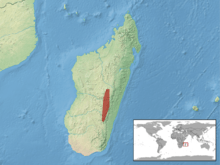Jewelled chameleon
| Jewelled chameleon | |
|---|---|
 | |
| Female Furcifer campani | |
| Scientific classification | |
| Kingdom: | Animalia |
| Phylum: | Chordata |
| Subphylum: | Vertebrata |
| Class: | Reptilia |
| Order: | Squamata |
| Suborder: | Lacertilia |
| Family: | Chamaeleonidae |
| Genus: | Furcifer |
| Species: | F. campani |
| Binomial name | |
| Furcifer campani (Grandidier, 1872) | |
 | |
| Synonyms | |
Furcifer campani, commonly known as the jeweled chameleon or the Madagascar forest chameleon, is a species of lizard in the family Chamaeleonidae. Furcifer campani is endemic to the central highlands of Madagascar, where it is threatened by bush fires and habitat loss.
Etymology
The specific name, campani, is in honor of Dominique Campan, a French resident of Madagascar.[3]
Description
Furcifer campani grows to a length of about 14 centimetres (5.5 in). The background colour varies from pale green through dark green to brown. There are three pale brown, lateral stripes running along each side of the body and numerous small bright-coloured spots between them. The head is often decorated with small red spots.[4] This chameleon has a crest running along its back composed of small projecting granules.[5]
Distribution and habitat
Furcifer campani is endemic to the central mountainous region of Madagascar where it lives at altitudes of 1,850 to 2,300 metres (6,070 to 7,550 ft). Its range extends from Ankaratra, an extinct volcano, to the Andringitra National Park, an area of 14,500 square kilometres (5,600 sq mi), but only part of this is suitable habitat and its population is fragmented. It is a terrestrial species and its habitat is mountain grass and heathland with shrubs and isolated trees.[1]
Biology
Chameleons are ambush predators, standing still and waiting for suitable prey to come within reach. The diet consists largely of insects which they catch by shooting out their long tongues which have sticky tips.[6]
Reproduction in Furcifer campani takes place two or three times a year. Clutches of eight to twelve eggs are laid in concealed locations. When reared in the laboratory, incubation takes about nine months at a temperature of 20 °C (68 °F) and the emerging juveniles are about 23 mm (0.9 in) long. The young grow fast and are sexually mature at three months. Some reports say that this chameleon hibernates, burying itself in leaf litter during the winter months.[5]
Status
In some areas of shrubby savannah grassland Furcifer campani is reported to be common but no real assessment of its abundance has been made.[5] The IUCN Red List of Threatened Species lists it as being "Vulnerable". This is because its habitat is being cleared for agricultural production and there is an annual cycle of burning.[1] It shares its range with the white-lined chameleon (Furcifer lateralis) and that species seems better able to cope with the disturbance and degradation to the habitat caused by humans. It should be safe from human disturbance in the national park but this is not the case on the Ankaratra mountains. Exports of Furcifer campani peaked in 1994 when over five thousand were removed from the island. Although the export of all chameleons from Madagascar has been banned since then, some may still be being collected. The IUCN consider that steps should be taken to limit the damage done by fires to the grassland where Furcifer campani is found.[1]
References
- 1 2 3 4 Jenkins RKB, Andreone F, Andriamazava A, Andriantsimanarilafy RA, Anjeriniaina M, Brady L, Glaw F, Griffiths RA, Rabibisoa N, Rakotomalala D, Randrianantoandro JC, Randrianiriana J, Randrianizahana H, Ratsoavina F, Robsomanitrandrasana E, Carpenter A (2011). "Furcifer campani". IUCN Red List of Threatened Species. Version 2012.2. International Union for Conservation of Nature. Retrieved 2012-12-26.
- ↑ Furcifer campani at the Reptarium.cz Reptile Database. Accessed 30 December 2015.
- ↑ Beolens B, Watkins M, Grayson M. (2011). The Eponym Dictionary of Reptiles. Baltimore: Johns Hopkins University Press. xiii + 296 pp. ISBN 978-1-4214-0135-5. (Furcifer campani, p. 46).
- ↑ "Jeweled chameleon (Furcifer campani)". ARKive. Retrieved 2012-12-19.
- 1 2 3 Brady LD, Griffiths RA (1999). "Status Assessment of Chameleons in Madagascar" (PDF). IUCN Species Survival Commission: 21, 31, 41.
- ↑ "Chameleons of Madagascar". WildMadagascar. Retrieved 2012-12-20.
